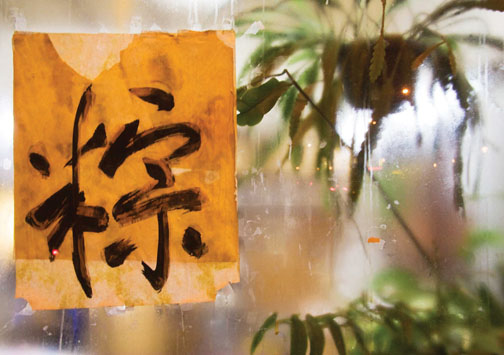The lifelong Palisadian, a former music industry executive and children’s book author, boldly takes on photography as her third act.

Sara Jane Boyers’ latest project, documenting the construction of a hilltop home in Malibu made of 747 airplane remnants, mirrors her own dramatic ascension to the ranks of serious photography. ‘I think with most photographers, their work is very much a reflection of themselves,’ she said during an interview in the Rustic Canyon home she and her husband, Steven, have shared for nearly 35 years. ‘I tend to have a certain reserve; it’s one of the reasons I don’t photograph people too often.’ Indeed, her work’particularly her decade-long pursuit photographing Chinatowns’exudes a sense of solitude and detachment, a provocative sort of emptiness. ‘I like the quiet moment,’ Boyers says. ‘A lot of my work is about peering in on a scene.’ The Chinatown series began in San Francisco 10 years ago when she was visiting colleges with her son, Morgan. She ventured into Chinatown early one morning armed with her camera and came away with some surprisingly rich images. ‘All of sudden, I had a focus,’ she recalls. Forty-five Chinatowns later, from a strip mall in Las Vegas to a cemetery in El Paso and an archeological dig of a once-populous Chinese community in Evanston, Wyoming, Boyers has a smartly honed body of work that will be featured in a show at Craig Krull Gallery next year. ‘I’m not looking for the exotic,’ says Boyers, who fondly remembers visits to L.A.’s Chinatown as a regular part of her childhood. ‘I view it as another part of American history; another aspect of the neighborhood.’ Boyers is well versed in the history of the Chinese and their immigration patterns in North America. Despite this, her meanderings through old and new Chinatowns are unstructured and all about chance: ‘What I know is different from what I photograph.’ Seattle stands out as an especially memorable shoot. After visiting a modern noodle factory filled with gleaming appliances, Boyers later stumbled upon Mr. Louie’s, a soulful storefront where inside an elderly man was making noodles by hand. ‘There was an ancient stove, some simple utensils and not much else,’ she says. ‘The scene had such emotional resonance.’ Boyers captured this ethereal moment in ‘Mr. Louie’s Kitchen,’ a photograph that has become a signature image in the series, along with ‘Mr. Louie’s Window,’ a shot of the exterior, where Chinese characters on a faded orange ‘paper sign animate an otherwise dreary, rain-soaked window. The latter is among the photographs in ‘Summer Mix: Images by Members of LACMA’s Photographic Council,’ an exhibition co-curated by Boyers that opened last weekend at the Creative Photography Workshops/Gallery on Wilshire across from LACMA. There’s a crispness and economy to Boyers’ visuals, qualities that come from years as a writer. ‘I’m so glad as a photographer that I was an editor first,’ says the author of several youth-oriented books including the award-winning ‘Life Doesn’t Frighten Me,’ a volume that pairs poetry by Maya Angelou with paintings by Jean-Michel Basquiat. Boyers wrote these books in the 1990s when her children, Morgan and Kate, now in their 20s, were teenagers. Inspired by them, she wanted to raise awareness about the art world among young people during a time when art curricula were the first to be cut from schools with strained budgets. ‘Whether as a follower, creator or collector, art is one of the most fulfilling pursuits,’ Boyers says. ‘It demands good critical thinking and is filled with intrigue and challenge.’ Her own exposure to art, particularly photography, came early to this member of the first graduating class at Palisades High School. Her father owned a photo lab in downtown L.A. After earning a bachelor’s degree in art history from UCLA, Boyers studied law at USC and went on to spend 20 years in the music industry as an attorney and personal manager of performers. Yet she never strayed too far from the art world. ‘I wrote a major paper about artists’ rights in law school,’ she says. Even the land she and her husband purchased back in the 1970s to build their current home boasts an art connection. It was sold to them by fellow Palisadians Charles and Ray Eames, the visionary husband-and-wife design duo. Despite her stated reserved, Boyers likes to laugh, often at herself, especially as it relates to ‘Gridlock,’ another current project that requires spending serious time on L.A.’s most congested freeways. ‘I’ll be listening to the news and realize ‘Oh, there’s traffic’ and become very excited,’ she says. Off she goes to find it, the slower moving the better to allow time to click and shoot from her car using a small Leica, a camera particularly associated with street photography. ‘All the while, I’m destroying my clutch,’ she says about the added challenge of driving a stick-shift car in the process. It’s the debris on the side of the road’a single high-heeled shoe, an abandoned surfboard. a crumpled newspaper’that catches her eye most often. Just as with the Chinatown series, she’s attracted to the abstracted details amid the chaos. Though the home in Malibu, one constructed from the salvaged and deconstructed parts of a 747 airplane, is much more of a spectacle to photograph, Boyers’ aesthetic approach remains much the same. ‘I’m interested in showing the wings and their interrelationships, both what’s intended and not intended.’
This page is available to subscribers. Click here to sign in or get access.



